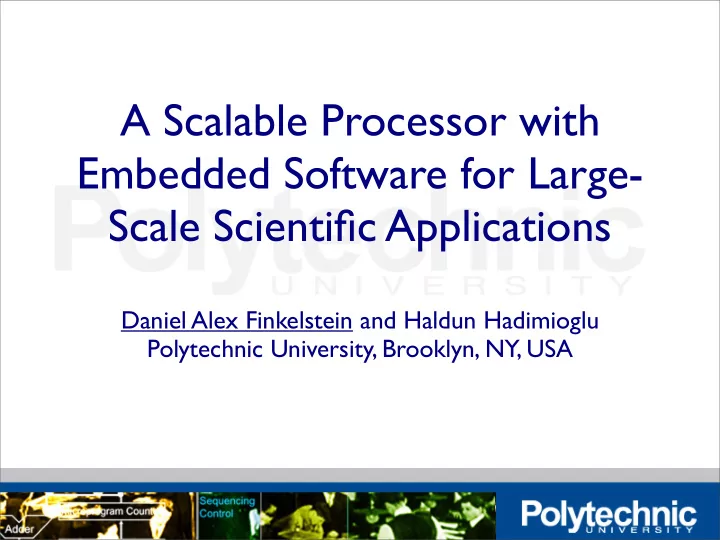

A Scalable Processor with Embedded Software for Large- Scale Scientific Applications Daniel Alex Finkelstein and Haldun Hadimioglu Polytechnic University, Brooklyn, NY, USA
Outline 1. Motivation/Goals and Related Work 2. Peripheral Context 3. Experimental Platform 4. Associative Streaming Memory Processor 5. Conclusions 2
Motivation & Goals 1. Address the memory wall problem • More intelligence in memory and storage usage • Target the CPU, main memory, and peripherals • Exploit regular scientific large-scale applications • For high-speed processing, reconfigurable fabric is needed • Use embedded RISC cores for ‘slow’ tasks and algorithms too difficult to directly map onto FPGA fabric. 3
Motivation & Goals 2. RISC + FPGA fabric combination • Schedules large & fine grained data movements • Associates data streams, data within streams, and mixes data streams on-chip or using latency- controlled peripherals (cache) 3. Scalability to handle large problems: Efficient Multi-Chip Configurations 4. Different mixture of processor-memory-fabric- peripheral composition 4
Related Work 1. Molen & Garp • Uses both FPGA reconfigurable logic and processor cores, but for application acceleration. Garp also allows FPGA direct access to main memory. 2. RAW • Programmable insofar as the instructions and data can be rerouted through the tiles via switching. 3. RAMP • Though a simulation environment, some of the (many) proposed features include dataflow architectures for programming languages, high- bandwidth peripherals, and reusable logic cores for the FPGA fabric. 4. RSVP • Decoupled operand prefetch, vector stream units, and detailed vector stream descriptors for media-rich applications, but can be generalized. 5
Supercomputing Applications Our criteria: • Large data sets • SPEC CPU 2000 FP suite - Stable, predictable • Floating point memory profiles operations • Regular data structures 6
Peripheral Bandwidth Intel Xilinx Intel 975X 3 Gbps SATA DDR DRAM 400 Mbps Virtex 4 Express Chipset Intel 975X 85.6 Gbps DDR2 DRAM DDR2 DRAM 667 Mbps Virtex 4 Express Chipset Intel IXP2855 Network 57.6 Gbps RDRAM Rocket I/O 75 Gbps Virtex-II Pro Processor Intel IXP2855 Network 10 Gbps Ethernet Infiniband 10 Gbps Virtex-II Pro X Processor Peripherals are getting faster, but are usually separated from the processors by several levels of the memory hierarchy. 7
ML310 Development Board 8
ML310 Development Board XC2VP30 FPGA with 2 PowerPC 405 RISC Cores 8
ML310 Development Board XC2VP30 FPGA with 2 PowerPC 405 RISC Cores 256 MB DDR DRAM 8
ML310 Development Board XC2VP30 FPGA with 2 PowerPC 405 RISC Cores 256 MB DDR DRAM SanDisk 8
ML310 Development Board XC2VP30 FPGA with 2 PowerPC 405 RISC Cores 256 MB DDR DRAM SanDisk IDE interfaces 8
ML310 Development Board XC2VP30 FPGA with 2 PowerPC 405 RISC Cores 256 MB DDR DRAM SanDisk IDE interfaces PCI 8
ML310 Development Board XC2VP30 FPGA with 2 PowerPC 405 RISC Cores 256 MB DDR DRAM SanDisk IDE interfaces PCI Ethernet 8
PowerPC - Custom IP Interface 9
PowerPC - Custom IP Interface 9
PowerPC - Custom IP Interface FPGA configurable fabric PowerPC Core D I 64 64 PLB PLB2OPB OPB 32 custom IP 9
PowerPC - Custom IP Interface Memory Options PowerPC Core D I 64 64 PLB PLB2OPB OPB 32 custom IP 10
PowerPC - Custom IP Interface Memory Options 64 I OCM 32 D (Block RAM) PowerPC Core D I 64 64 PLB PLB2OPB OPB 32 custom IP 10
PowerPC - Custom IP Interface Memory Options 64 I OCM 32 D (Block RAM) PowerPC Core D I 64 64 32 64 DDR PLB DRAM PLB2OPB 16 32 64 OPB 32 custom IP 10
PowerPC: A High Level Controller 11
PowerPC: A High Level Controller • PowerPC (PPC) core PPC (with some hardware User additions) can execute Code user programs 11
PowerPC: A High Level Controller • PowerPC (PPC) core PPC (with some hardware User additions) can execute Code user programs • PPC core may also PPC perform control and High monitoring functions for User Level Code Controller the processor system 11
High Level Controller Features • Peripheral latency Store delays between data request and data arrival for each monitoring peripheral • Peripheral data prefetch Begin retrieving data streams and control process immediately or buffer locally, based on latency values • Peripheral resource Control access to peripherals scheduling Vectorized data streams allow • Coarse-grained data the controller to associate association, mixing, and streams with each other buffering (dependencies), re-order data into memory buffers (useful in matrix- matrix multiplication and transposes), etc. 12
Low Level Controller Features • The LLC is the Custom Low level controller is unique for each application. IP (shown earlier) connected to the OPB Reusable functional logic can be dynamically mapped onto CLBs at • The LLC resides within compile-time or run-time. the FPGA’s configurable logic blocks (CLBs) Control signals exchanged with HLC to indicate status of buffers, dout_rdy, etc. • The LLC performs both computations on the Data element arithmetic data streams and fine- operations (int/FP) performed at grained data mixing this level. Elements in streams may be remixed to satisfy output constraints, dependent instructions, etc. 13
HLC - LLC Interaction FPGA CLB Fabric register interface PPC 32 High Low User Level Level Code Controller Controller 14
Conclusions • Fast peripherals need not be limited by intermediate controllers, buses, and operating systems. • Controller logic can be integrated alongside traditional processor components in a single package. • Intelligent use of memory peripherals on local buses reduces processing latencies. • Embedded software saves resources better devoted to time-sensitive computation. 15
Acknowledgments We wish to acknowledge the support of Xilinx in providing us with ML310 development boards, design tools, and technical support. This work was supported in part by a research fellowship from the U.S. Department of Education GAANN. 16
Thank you. contact: dfinke01@cis.poly.edu 17
Recommend
More recommend